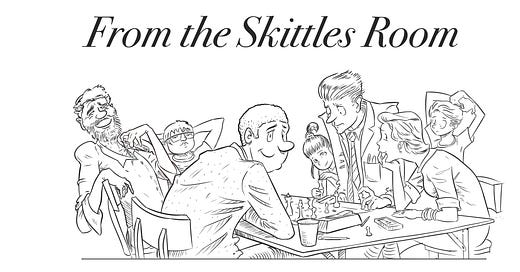The Marshall Spectator

In This Issue:
From The Skittles Room
King's Kibitzes: The Myth of the Mistake, FM Alex King
Marshall Memories from a Former Club Champion, GM Andy Soltis
Across the Table: NM Aakaash Meduri
Chess Toons
En Passant
Problem of the Week
Editor's Note

Welcome back, fellow chess players, to this edition of the Marshall Chess Club's fortnightly bulletin, The Marshall Spectator.
Are you looking for a gift for that special someone? Take a look at the merchandise in our new store that launched just in time for the holiday season. If you're a member, use code "marshall2022" when you checkout for a discount and be sure to keep an eye out for additional forthcoming items in the months ahead.
In the last two weeks, we have had a copious offering of rated events at our historic club.
The Weekly Wednesday Under 1600 that ended on November 30 had 26 players registered, and a single clear first place finisher. Gary Chan won $250 for his 5.5 out of 6 score, while Dzmitry Kharchykau won the second place prize of $150, scoring 5 out of 6. There was a three-way tie for the remaining prizes between Nicholas Beirne, Paulo Paz and David Smith who earned $66.67 each for their 4 out of 6 performance.
The Weekly Wednesday Under 2200 that ended on November 30 had 40 players in the event and was won by Nkosi Nkulueko, who scored 5 out of 6 and earned $380 in the process. Second place in that event went to George Berg who scored 4.5 out of 6, winning $228. Alexander Golosovker won the class prize of $152, and there was a six-way tie among Robert Donald Olsen, Ilya Levkov, Aleksandr Gutnik, Justin Venezuela, Serge Adelson and John Brendel for the remaining prize funds amounting to $25.33 each.
The Michael Rohde Action Tournament on December 1, had 23 players registered to play and 2 players finishing with a perfect 4 out of 4 score. GM Aleksandr Lenderman and Ted Belanoff won $77.31 each, while James Oh won the class prize of $51.50 for his 3 out of 4 performance. Linxi Zhu and Mouhamadou Tall split a class prize, earning $25.75 each, and the upset prize went to Alvaro Lopez.
The Jerry Simon Memorial that ended on December 4 had an astounding 67 players registered. The clear first place prize of $825 went to NM Aakaash Meduri who scored 5 out of 6 and is this years Marshall Chess Club Amateur Champion and Jerry Simon Memorial winner. He is also featured in this issue's edition of The Marshall Spectator's Across the Table column. Eshaan Hebbar, Pranav Shankar and Theodore Chachere won $192.50 each for their effort, while Nicholas Bear won the class prize of $165. Christopher He and Charles Ho split the remaining class prize money, earning $41.25 each for their performance.
The Rated Beginner Open that ended on December 4 had 24 players registered and a three-way tie for first place between Jaime Jariton, Oliver Cooke and Taj Mateo who earned $76.67 each for their perfect 3 out of 3 performance.
The Monday Under 1800 that ended on December 5 had 7 players registered and was won by Tommy Kimberlin who scored 5 out of 6, winning $125 in the process. John Walton won clear second in that event with 3.5 out of 6, earning $75, while Jun Xiang and Ken Jennings won the class prizes of $50 each.
The FIDE Monday that ended on December 5 had 26 players registered and a two-way tie for first place between Daniel Frank Johnston and Alberto Arnedo Ruiz who scored 4.5 out of 6 and earned $250 each for their efforts. There was a three-way tie between Anthony Levin, Robert Donald Olsen Jr. and Aleksandr Gutnik for the remaining prize money, netting $83.33 each for their effort.
To see these and all other recent results, click here. You can see who has gained the most rating points in our recent events by clicking here.
Photo courtesy of Professional Photographer Molly Woodward.
Looking ahead to the next few weeks, the 106th annual Edward Lasker Memorial and Marshall Chess Club Championship will crown a club champion this weekend, whose name will be added to this illustrious list of past champions dating back to 1917. To follow the action live, watch Luis Henrique Coelho's commentary on twitch! The games will also be broadcast on chess.com, chessbase, and DGT Livechess.
On Friday December 16th, we will once again host our Women & Girls Open tournament, a 3 round event for female chess players only.
The Marshall Chess Club will be closed on December 24th and December 25th, however, on Tuesday December 27th, we will be having another casual chess and pizza social for members- we look forward to seeing you there!
At the end of the month, our famous New Year's All Nighter tournament will run from December 31st to January 1. How much do you really love chess? Prove it to yourself and your peers by registering for this 12 round marathon of 36 hours of non- stop rated chess! For details, please check our club calendar.
Finally, we would like to recognize our many scholastic members who played this past weekend in National Harbor, Maryland at the Grade National Championships. Below is a list of club members who finished in the top 15 spots in their section (excluding under prizes, class prizes or side events such as the blitz.) Congratulations to our many talented young players who shined bright on the national stage!
12th Grade
4th place, Leonardo Liu, Columbia Grammar & Prep
10th place, Anya Jain, Columbia Grammer& Prep
11th Grade
3rd place, Gus Huston, Dalton
5th place, IM Maximillian Lu
8th place, Natheniel Shuman, Dalton
10th place, Julia Miyasaka, Dalton
10th place, Jessica Hyatt, Success Academy HS Liberal Art
10th place, Henry Burton, Hunter College Campus School
10th place, Graham Smith, Columbia Grammar & Prep
10th Grade
2nd place, FM Nico Chasin, Columbia Grammar & Prep
3rd place, Toshinori Underwood, Brooklyn Technical High School
8th place, CM Jack Levine, Hunter College Campus School
10th place, CM Max Mottola, Dalton
10th place, CM James Oh, Columbia Grammar & Prep
10th place, Krish Bhandari, Stuyvesant HS
10th place, Timothy Ng, Hunter College Campus School
9th Grade
4th place, Jed Sloan, Stuyvesant HS
10th place, Aritro Chakravarty, Stuyvesant HS
10th place, William Safranek, Dalton
10th place, Siddharth Ganti-Agrawal, Hunter College Campus School
10th place, Ian Nicholson, Hunter College Campus School
10th place, Alexandra Lussie, Stuyvesant HS
8th Grade
1st place, Brewington Hardaway, Speyer Legacy School
3rd place, Aiden Reiss, Home School
8th place, Chloe Gaw, Chapin School
13th place, Nathaniel Mullodzhanov, Success Academy Hudson Yards
15th place, Christian Higgins, Success Academy Hudson Yards
15th place, Kory Chen, Success Academy Hudson Yards
15th place, Morgan Kenzo Mairaj, Hunter College Campus School
15th place, Joseph Wallace, Success Academy Hudson Yards
15th place, Romir Mukherjee, Hunter College Campus School
7th Grade
10th place, Narayan Venkatesh, Chapin School
15th place, Max Chang, Hunter College Campus School
15th place, Avaan Chamadia, Collegiate School
6th Grade
11th place, CM Aditeya Das, Success Academy Hudson Yards
15th place, Whitney Tse, Speyer Legacy School
5th Grade
7th place, Connor Wang, Quaker Ridge (Scarsdale, NY)
10th place, Eden You, Ethical Culture Fieldston
12th place, Suvan Baranwal, Tag Young Scholars
14th place, Bryson Wolf, Hunter College Campus School
15th place, Connor Liao, PS 41
4th Grade
1st place, CM Kyle Dong, Fort Lee School No 1
3rd place, Elliot Goodrich, PS 77 - Lower Lab School
7th place, Jeremy Tao, Dalton
9th place, Phineas Weingarten, A&L 305 United (Brooklyn)
14th place, Derek Zhang, PS 89 Liberty School
15th place, Alice Chovanec, Anderson School
15th place, Leo Shen, Tag Young Scholars
15th place, Daisy Yuen, Speyer Legacy School
15th place, Isaac Statz, Speyer Legacy School
15th place, Jude Badawi, PS 33 Chelsea Prep
3rd Grade
3rd place, Sujia Diao, Ridge (Ridgewood, NJ)
6th place, Linxi Zhu, Anderson School
7th place, Lucas Yang, Speyer Legacy School
9th place, Lev Shangin, Speyer Legacy School
15th place, Raza Patel, Speyer Legacy School
15th place, Manish Kashyap
15th place, Takki Tanaka, PS 77 - Lower Lab School
2nd Grade
1st place, Alice Shen, Anderson School
6th place, Sasha Schaefer, Anderson School
10th place, Ethan Kim, PS 77 - Lower Lab School
1st Grade
5th place, Ian Singh, Speyer Legacy School
7th place, Thomas Egelhof, PS 9
10th place, Milan Rajendran, Collegiate School
12th Grade Team
1st place, Columbia Grammar & Prep
3rd place, Stuyvesant HS
4th place, Hunter College Campus School
11th Grade Team
1st place, Dalton
2nd place, Stuyvesant HS
3rd place, Columbia Grammar & Prep
4th place, Success Academy HS Liberal Art
10th Grade Team
2nd place, Columbia Grammar & Prep
3rd place, Hunter College Campus School
4th place, Stuyvesant HS
5th place, Success Academy HS Liberal Art
9th Grade Team
2nd place, Stuyvesant HS
3rd place, Hunter College Campus School
8th Grade Team
1st place, Success Academy Hudson Yards
2nd place, Hunter College Campus School
4th place, I.S. 318
7th Grade Team
1st place, Hunter College Campus School
3rd place, Success Academy Midtown West
4th place, I.S. 318
6th Grade Team
2nd place, Speyer Legacy School
3rd place, Columbia Grammar & Prep
4th place, Success Academy Midtown West
5th Grade Team
1st place, Hunter College Campus School
2nd place, PS 10 (Brooklyn)
3rd place, Success Academy Midtown West
4th place, Dalton
5th place, Collegiate School
6th place, Success Academy Hudson Yards
7th place, PS 41
8th place, Anderson School
9th place, Tag Young Scholars
10th place, PS 33 Chelsea Prep
4th Grade Team
1st place, Speyer Legacy School
2nd place, Dalton
3rd place, PS 77 - Lower Lab School
4th place, Tag Young Scholars
5th place, Anderson School
6th place, PS 33 Chelsea Prep
8th place, Hunter College Campus School
10th place, Avenues: The World School
3rd Grade Team
1st place, Speyer Legacy School
2nd place, PS 77 - Lower Lab School
3rd place, Anderson School
5th place, Dalton
6th place, Success Academy Union Square
9th place, Success Academy Bensonhurst
10th place, PS 33 Chelsea Prep
2nd Grade Team
2nd place, PS 77 - Lower Lab School
3rd place, Anderson School
4th place, Hunter College Campus School
5th place, Avenues: The World School
1st Grade Team
1st place, Speyer Legacy School
3rd place, Success Academy Union Square
4th place, PS 9
5th place, Dalton
Kindergarten Team
2nd place, Trinity School
3rd place, Dalton
4th place, Speyer Legacy School
5th place, PS 33 Chelsea Prep
— Greg Keener, Editor of the Spectator
King's Kibitzes: The Myth of the Mistake
In my , “The Myth of the Advantage,” I introduced some principles of a “fundamentalist framework” for chess analysis. Among those principles are that "all positions have a WDL [win/draw/loss] evaluation, regardless of to what degree that evaluation is known," and therefore that “slight advantage and clear advantage are myths.”
A reader responded with a , rightly observing that “...this type of evaluation is a myth, we are humans. We all live by myths.” I agree, but I still strongly believe that a more “scientific, rigorous, and consistent” method has many benefits, and so I will continue to outline it in this follow-up column.
Consider the following example from the recent Olympiad. The analysis has been adapted from my recent Facebook post:
Rameshbabu Praggnanandhaa (2648) - Javokhir Sindarov (2629)
Chennai 2022
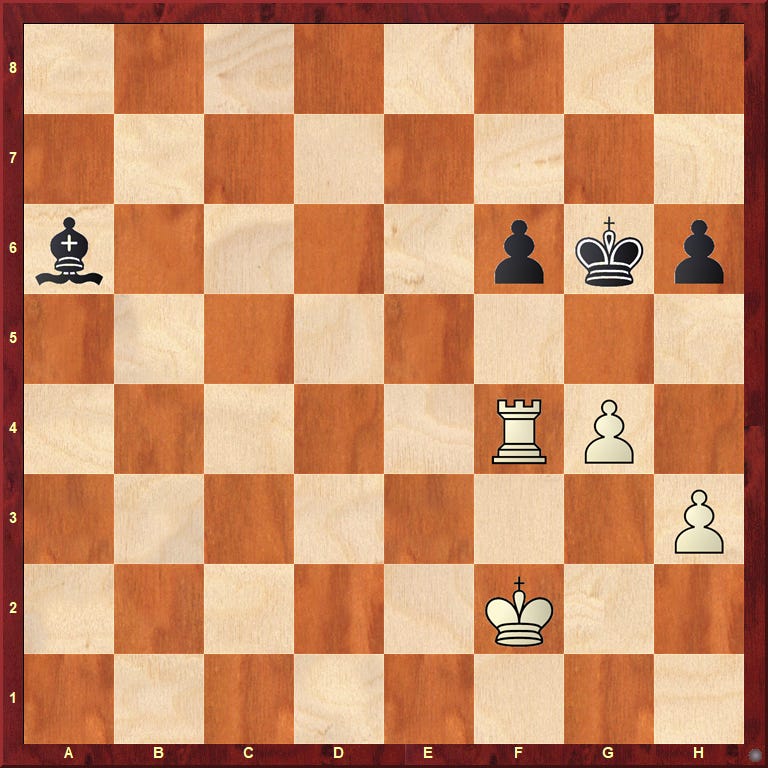
43…h5 44.gxh5+ Kxh5 45.Rxf6 Bd3 46.Kg3 Bg6 47.Ra6 Bd3 48.Ra5+ Kh6 49.Kh4 Kg6 50.Rg5+ Kh6 51.Rd5 Bc2 52.Rd6+ Kg7 53.Kg5 Bb1 54.Rd7+ Kg8 55.Rc7 Bd3 56.Kh6 Bf5 57.Rg7+ Kf8 58.Rg3 Bc2 59.Rg2 Be4 60.Rg1 Kf7 61.Rg4 Bd3 62.Rg3 Bc2 63.Rg2 Bd3 64.Rg7+ Kf8 65.Rg3 Bc2 66.h4 Kf7 67.Rc3 Bb1 68.Rf3+ Kg8 69.Rg3+ Kf7 70.Rg7+ Kf8 71.Rg5 Kf7 72.Kh5 Kf6 73.Kg4 Bc2 74.h5 Bd1+ 75.Kf4 Bc2 76.h6 Bg6 77.Rg1 1-0
In the above sequence of moves, Lichess's automated computer analysis identifies two "inaccuracies," two "mistakes," and two "blunders" for Black, and one "inaccuracy" and one "mistake" for White:


Sounds like pretty bad endgame play by both sides, right? Wrong. None of those eight moves, or any other move by either side from moves 44 to 77, changed the tablebase evaluation - White was winning the entire time.Take a look at move 58, for example:
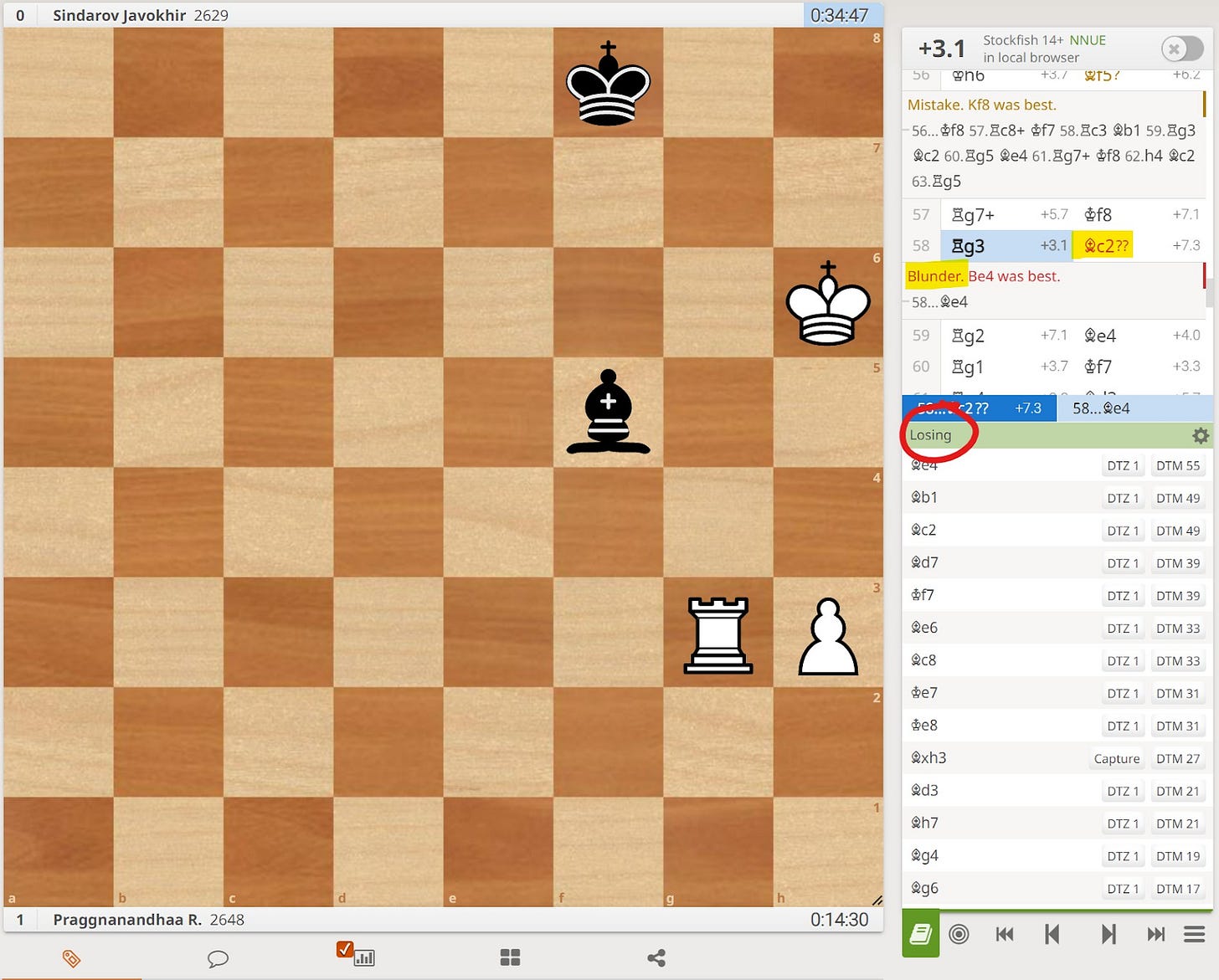
The auto-analysis calls Black's 58...Bc2 a "blunder," but the tablebase reveals that all of Black's moves are losing.
Strictly speaking, it is impossible to blunder, or indeed to make any objective mistake at all, in a position where you are already losing. In an absolute sense, a position cannot be "more" or "less" losing - it's either losing, or it's not losing (i.e. a draw, or a win).
Likewise, strictly speaking it is impossible for a move which retains a winning evaluation to be a "mistake" (as the auto-analysis describes White's 63.Rg2), or even an "inaccuracy" (as the auto-analysis describes White's 62.Rg3). Again, in an absolute sense, there is no "more" or "less" winning - all moves which retain a winning evaluation are equivalently good.
Of course, one can argue that certain moves are more "practical" or "logical" or "safe" or "easy" than others, even among options which are objectively equivalent. These claims are easy to make, but hard to quantify or measure, and therefore hard to falsify, or to implement consistently or scientifically.
So, in a scientific sense, there is no such thing as an inaccuracy. A move either preserves the existing evaluation, in which case it is a good (or perfectly fine) move, or it spoils the existing evaluation, in which case it is a bad move. It’s “blunders or nothing”, as one of my students succinctly put it.
Here is the scale I presented in my last column for translating the numerical evaluation of Stockfish 15 into a WDL evaluation:

Since then, Stockfish 15.1 has been released, featuring a recalibrated numerical evaluation scale that is more compressed, with +1.40 already strongly predicting the top “W (winning” category above. But regardless of the exact numbers, the basic framework I outlined last month remains the same: “Certain numerical evaluations strongly predict a certain WDL evaluation, while other numerical evaluations do not strongly predict a WDL evaluation.”
A corollary of this evaluation scale is the following convention for the use of annotation symbols, which is similar to the conventions used by John Nunn and Robert Hübner:
! The one unique move necessary to preserve the existing categorical evaluation.
? A move which shifts one objective category, i.e. from W to D or from D to L.
?? A move which shifts two objective categories, i.e. from W to L.
!!, !?, and ?! These symbols have no objective or consistent definition, and I don’t use them.
Note that if a move goes from W to indeterminate, that means that it is also indeterminate whether or not it is an objective mistake, and so there is insufficient evidence to assign it a “?.”
Here is an example of what a game looks like when analyzed using the above evaluation scale and annotation convention. I analyzed it manually with SF15 running on my laptop:
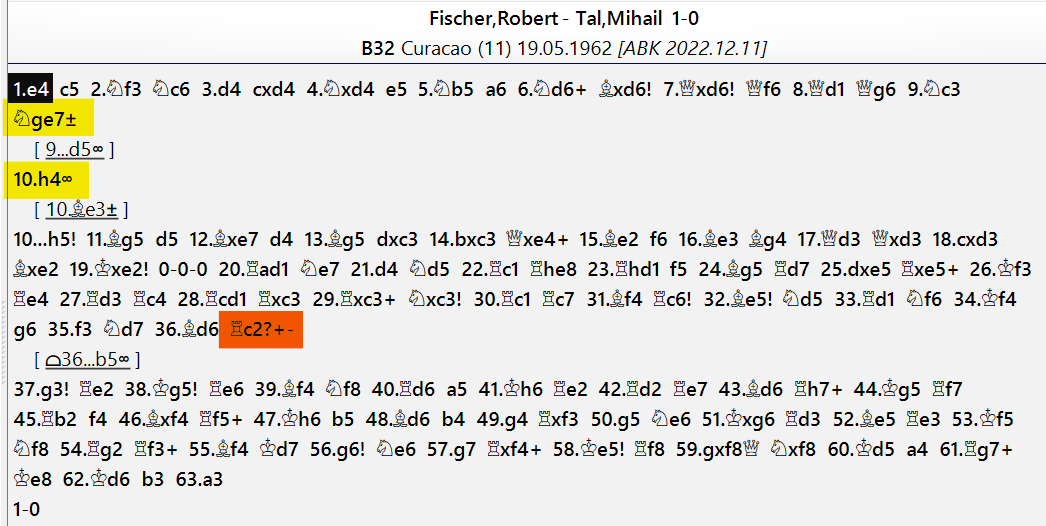
Tal’s 9…Nge7 changes SF15’s evaluation from about +0.60 (if Black had played SF15’s top move 9…d5) to about +1.10, and then Fischer’s 10.h4 brings the evaluation down to about +0.80. Did Fischer miss a win there? Maybe, maybe not - I prefer to say that it’s indeterminate, which is another way of saying that there is insufficient evidence that Tal’s 9…Nge7 and Fischer’s 10.h4 are or aren’t decisive mistakes. With stronger software or hardware, and/or longer thinking time, a more determinate evaluation could be established, but until then, “indeterminate” is a placeholder.
Tal’s 36…Rc2?, on the other hand, is definitely a decisive mistake (or simply a “mistake”) - it changes the evaluation from about +0.25 to about +2.50, which means that it goes from a strongly predicted D to a strongly predicted W.
Just in the past two months I have analyzed almost 500 such historical games using this analysis framework. I find it to be remarkably efficient, and the resulting streamlined data to be consistent and free of myths and clutter.
Try this method out for yourself! I’m still developing it, and I welcome more feedback and critique.
— FM Alex King, Spectator Columnist
Marshall Memories
The Marshall has a wonderful history but much of it is unrecorded. You won’t find it in books, old magazines or even by googling. Only longtime members will remember, for example, the club’s working dumbwaiter, the hated “rapid transit” buzzer, the “Bridge Room,” and the Marshall’s beloved cat.
The cat was an orange-colored stray tabby, apparently found on the street outside the club and quickly adopted by Marshall members around 1985. He had a winning personality but needed a name. “When someone said ‘Gambit’ we knew it was a great name -- and it stuck,” said Matt Gross, one of Gambit’s longtime guardians.
For several years, Gambit called the Marshall home. He prowled from room to room, often greeting anyone at the front door. He was fed and cared for by members.
Gambit deserves at least a footnote in chess history, like world champion Alexander Alekhine’s pet cat “Chess,” whom he brought to tournaments. But the only allusion I’ve found to Gambit is in a Russian book, co-authored by Anatoly Karpov.
It claimed a cat jumped from a Marshall mantelpiece onto Dmitry Gurevich’s board during an international tournament. This startled his opponent, who blundered and permitted Dmitry to earn his final grandmaster norm, the book said. (Dmitry, a cat lover himself, told me Karpov’s tale is quite untrue.)
Marshall regulars with longer memories will recall the club’s dumbwaiter and its role in a murder mystery novel. As in other vintage Village townhouses, the dumbwaiter brought food from the kitchen to be served on the second floor. It was described with some accuracy by a widely read author, Rex Stout, in his 1962 book “Gambit.”

In Stout’s plot, a chess prodigy is murdered in the prestigious “Gambit Chess Club,” which bore a strong resemblance to the Marshall and was located on West 12th Street, between Fifth and Sixth Avenues. Stout’s celebrated detective, Nero Wolfe, solved the crime by determining how the victim’s body was moved -- by the dumbwaiter.
Veteran Marshall members also recall when the club’s downstair’s room was called the “Bridge Room.” The name came from the sessions of rubber bridge played there on Tuesday nights. Chess celebrities like Grandmaster Arthur Bisguier and Chess Review publisher Al Horowitz were members of the rival Manhattan Chess Club but paid to play bridge at the Marshall.
While they were downstairs on Tuesdays, the Marshall held “rapid transit” tournaments on the second floor. These were speed chess round robins played without clocks. The old-style clocks were considered too fragile for blitz pounding. Instead, a loud, electronic buzzer sounded every ten seconds. The player whose turn it was to move had to move or be forfeited.
No one liked the buzzer. Imagine the obnoxious sound heard when a TV game show contestant answers a question wrong. Our buzzer was much louder. It was finally retired when sturdier clocks were introduced.
The bridge players were ousted after the “Fischer Boom” of the early 1970s, when the club needed more space for its sharply increased membership. There was also a brief period when the street-level, downstairs front room (now a psychotherapist’s office) held the club’s strongest tournaments. Marshall member Eric Schiller began his career as an international arbiter by organizing all-master round robins in that space during 1979-1980. Schiller eventually served as arbiter for two of Kasparov’s world championship matches.
Of course, there’s a lot more to say about Marshall club lore. But if you want to learn a lot about the “Capablanca table,” about how Frank, Carrie Marshall and their son Frankie lived upstairs in the building. Or about the fabulous Gustave Pfeiffer chess set collection that was on display in the second-floor back room, you won’t find it by googling. You’ll have to ask a Marshall member with many fond memories.
— GM Andy Soltis, Former Marshall Chess Club Champion
(1967,1969,1970,1971,1974,1977,1979,1986, 1988)
Across The Table: Aakaash Meduri
When did you start playing chess and how did you learn?
My father taught me when I was in preschool, and I played in my first USCF rated tournament in second grade. I don't remember much from this time, but I do remember one of my first teachers was Senior Master Richard Verber.
How long have you been coming to the club?
Only two months! I joined Marshall as soon as I moved to NYC in October.
What’s your favorite opening trap?
I am a proud, card-carrying degenerate of the London System club.
Any great game that you've played at the Marshall that you'd like to share?
My game against Marshall President and NM Sarathi Ray was a rollercoaster.
Aakaash Meduri vs Sarathi Ray
2022 New York MCC Amateur Championship
(Play through the game here.)
Both Sarathi and I were on 3-0, so this game would be critical for both of our chances to qualify for the MCC Championship.
1. d4 Nf6 2. Nc3 d5 3. Bf4 c6 4. e4?!

Improvised OTB. The day before, Sarathi had played a brilliant attacking game with the White pieces. When I saw the pairing, my initial plan was to go for a solid approach. However, I arrived 20 min late to the game due to repairs at the subway station. Since things already weren't going according to plan, I decided to embrace chaos and see what would happen. (4. e3 is the main move by far. Many interesting Jobava London positions can arise from here.)
4... Nxe4! 5. Nxe4 dxe4 6. Bc4 Nd7 7. Ne2 Nf6 8. O-O Bg4 9. h3 Bh5 10. g4 Bg6 11. Be5!?
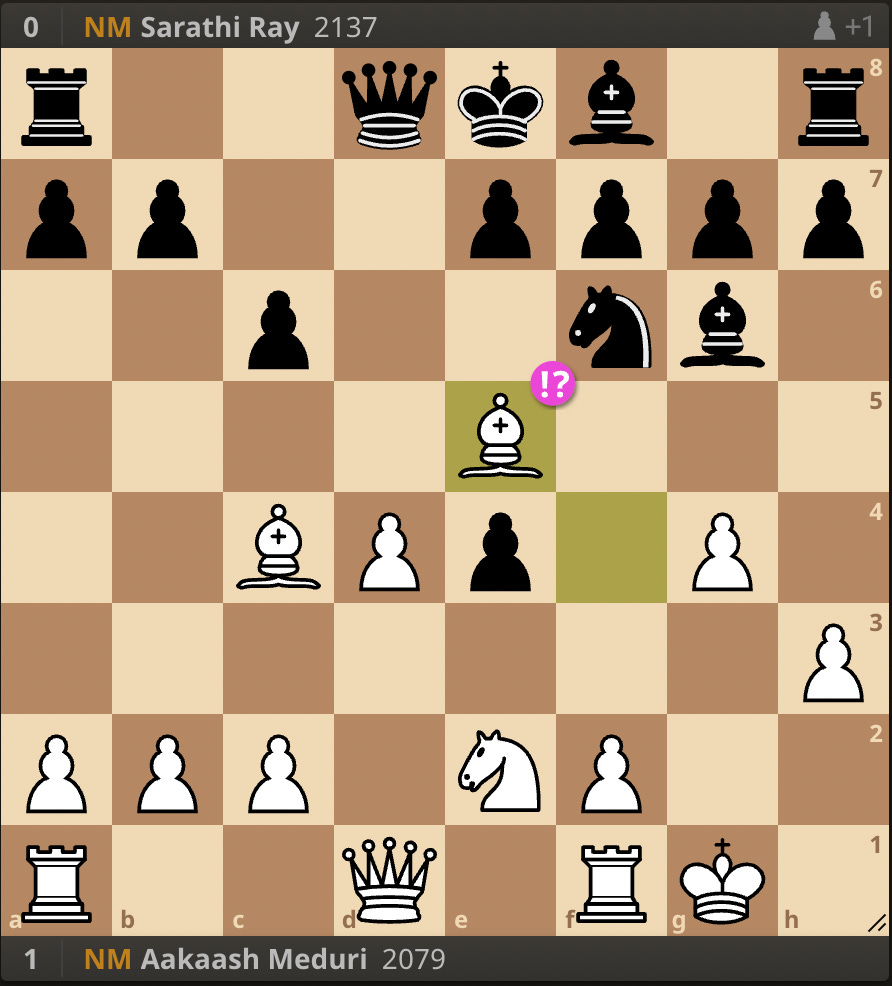
If Black easily completes his development and consolidates, I will be much worse since I am already a pawn down. The position demands energetic play.
11... e6 12. f4 exf3 13. Nf4 Be7 14. Qxf3 O-O 15. Rae1 I offered a draw at this move and did not expect him to take it. But I felt the consideration of whether or not to accept could introduce some psychological uncertainty, which might aid me down the road.
15... Bxc2! Playing on is correct. Black is up 2 pawns, and White needs to prove something of his position. Stockfish evaluates this as -1.9 in Black's favor.
16. Rf2 Bg6 17. h4 Nxg4?
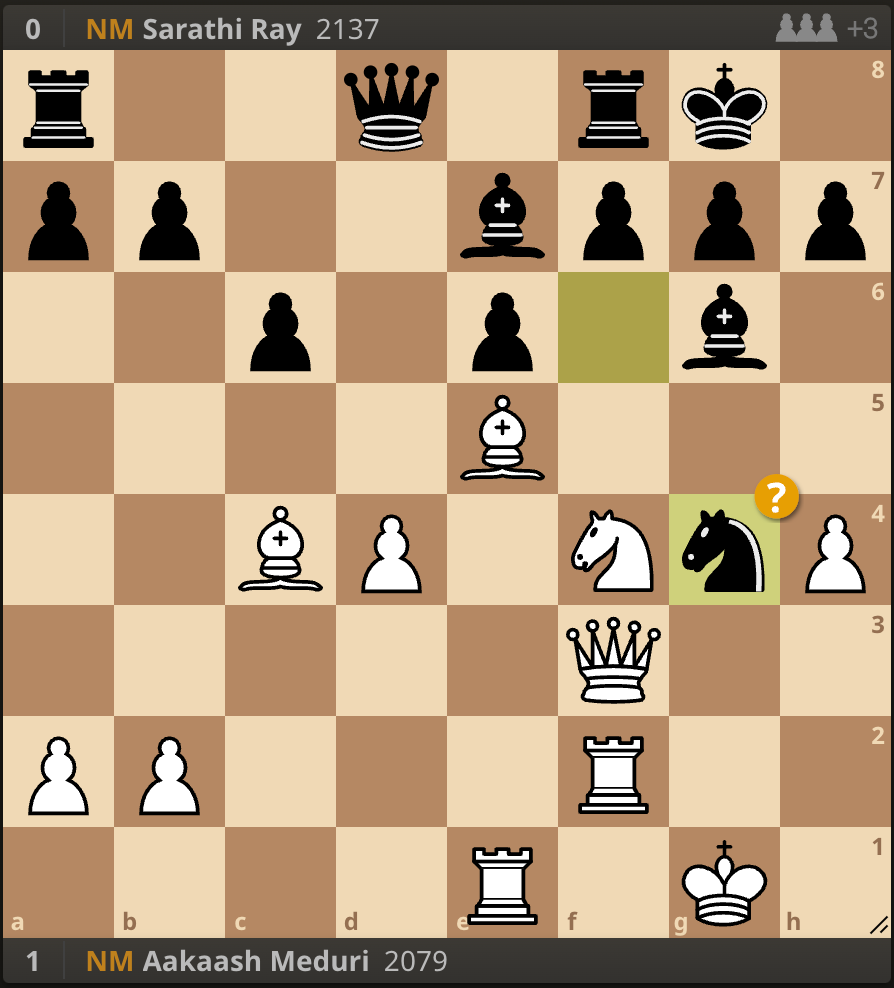
Now White has open files to work with. (17... Nd7 18. h5 Nxe5 19. dxe5 Bxh5 20. gxh5 Bc5)
18. Qxg4 Bxh4 19. Rh2 Bxe1 20. Kf1?

Based on a faulty idea that we will see come to fruition. (20. Nxg6 hxg6 (20... fxg6?? 21. Qxe6+ Kh8 22. Qxg6 Black is getting mated.) 21. Kf1! The King serves as an attacker in the middlegame! White tries to divert the bishop so the queen can go to h3. 21... Qe7 (21... Bb4 22. Qh3 with mate to follow.))
20... Bb4 21. Rxh7 Kxh7 22. Bxe6 I had seen this position from afar and for some reason thought it was a Tal-like winning attack. But Black is of course not obligated to take the bishop.
22... Bd6 Black correctly tries to exchange pieces. White's attack is fizzling out.
23. Ke2 Bxe5 24. Qh3+ Kg8 25. Nxg6 fxe6 26. Qh8+ Kf7 27. Nxe5+ Ke8

I considered resigning at this point. After all, White has a knight for two rooks. But I was already playing off the increment, and the geometry of the queen and knight felt annoying enough to cause some problems.
28. Qh5+ Ke7 29. Qg5+ Kd6 30. Qxg7 Qe7 (30... Kd5 is good enough too but feels unnecessarily risky.)
31. Qg3 Threatening discovered check and a skewer on a3.
31... Qh7 (31... Kc7 There are no useful discovered checks. I was going to resign if this was played.)
32. Nc4+ Kd5??
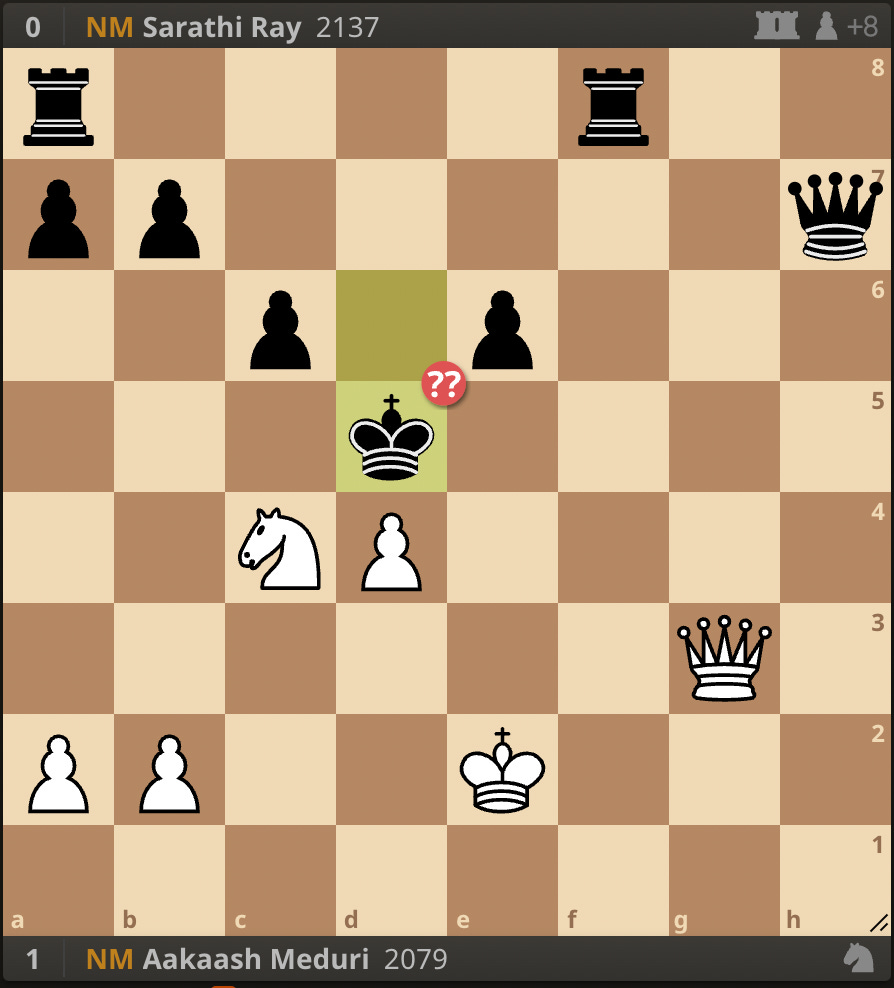
A shocking blunder. I can only speculate this was due to fatigue. (32... Kd7! 33. Qd6+ Ke8 The line Sarathi must have missed. White is dead lost. ) (32... Ke7?? 33. Qc7+ drops the queen.) 33. Qe5+ 1-0 White wins. Sarathi resigned here, seeing what was coming. 33... Kxc4 34. Qc5#
A barn burner of a game that I should lose 99% of the time. Regardless of the outcome, it's games like this which remind us why we play chess.
What about yourself would you like other members to know, that we may not know! Any surprising facts?
Some may recognize me from my Twitch channel, although I haven't streamed much lately. On a more interesting note, I recently got a chess tattoo. You'll have to ask me in person to see it :)
— NM Aakaash Meduri, Marshall Chess Club Member
Chess Toons

En Passant
– GM Aman Hambleton beat IM Lawrence Trent with a technical knockout (TKO) during Sunday's Mogul Chessboxing Championship.
– GM Tan Zhongyi defeated GM Aleksandra Goryachkina on Saturday in the fourth game of their Women's Candidates semifinal in Khiva, Uzbekistan. In doing so, Tan qualified for an all-Chinese final vs. GM Lei Tingjie, which is scheduled for the first quarter of 2023.
– At the end of the year, the FIDE World Rapid & Blitz Championships will be played in Almaty (Kazakhstan). The first day of play is 26 December. Top seeds in the rapid open are Magnus Carlsen, Hikaru Nakamura, Jan-Krzysztof Duda, Maxime-Vachier Lagrave, Ian Nepomniachtchi and Alexander Grischuk.
– The Sunway Chess Festival, sponsored by Chessable, is set to take place on December 12-22 at the Playa Golf Hotel in Sitges, Catalonia. Two massive open tournaments will be played at the paradisaic resort southwest of Barcelona. Over 300 players have registered to participate in the main group, with the likes of Yu Yangyi, Andrey Esipenko and Vasyl Ivanchuk.
Problem of the Week
Bryson vs Dick Smit, 1999

Black to move and win.
This position is not a composition, but rather an interesting tactic taken from a correspondence game. Here, it was Black to move and win - how?
---
David Gurgenidze, 1976

White to move and win
Solution to David Gurgenidze, 1976: 1.Ne2! The knight will head to c6, allowing the pawn to promote. For instance 1...Rd2 2.Nd4 Ka5 3.Nc6 and the pawn cannot be stopped.
—Alexander George & Greg Keener, Marshall Chess Club Members
Editor's Note
As always, if you have any feedback, comments, or would like to submit an article please contact us directly at td@marshallchessclub.org.
Enjoy, and thanks for reading!
The Marshall Chess Club
Address: 23 West Tenth Street New York, NY 10011
Contact: 212.477.3716; td@marshallchessclub.org
Hours: Monday 1pm-Midnight; Tuesday - Closed, Weds-Fri 1pm-Midnight; Sat/Sun 9am-Midnight



